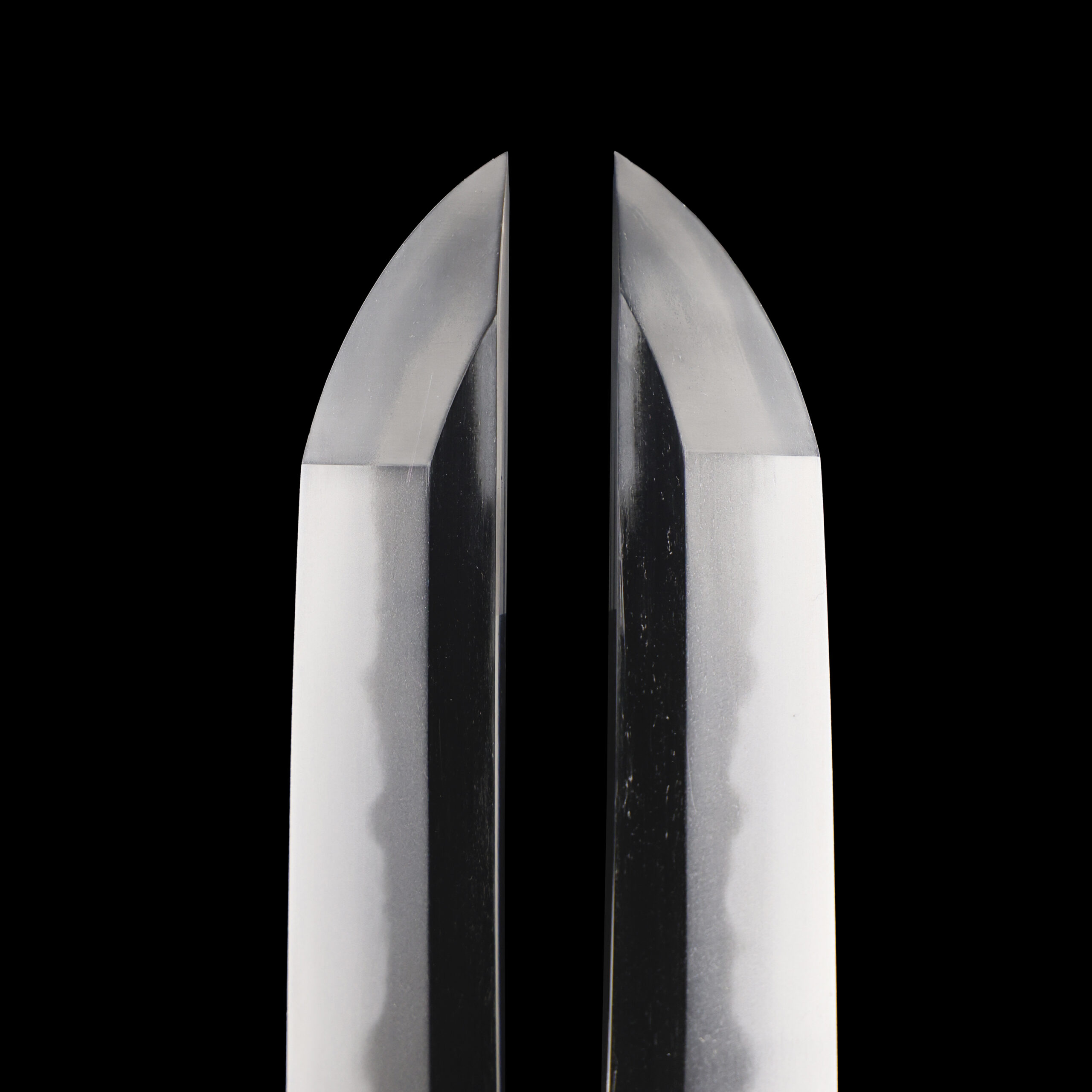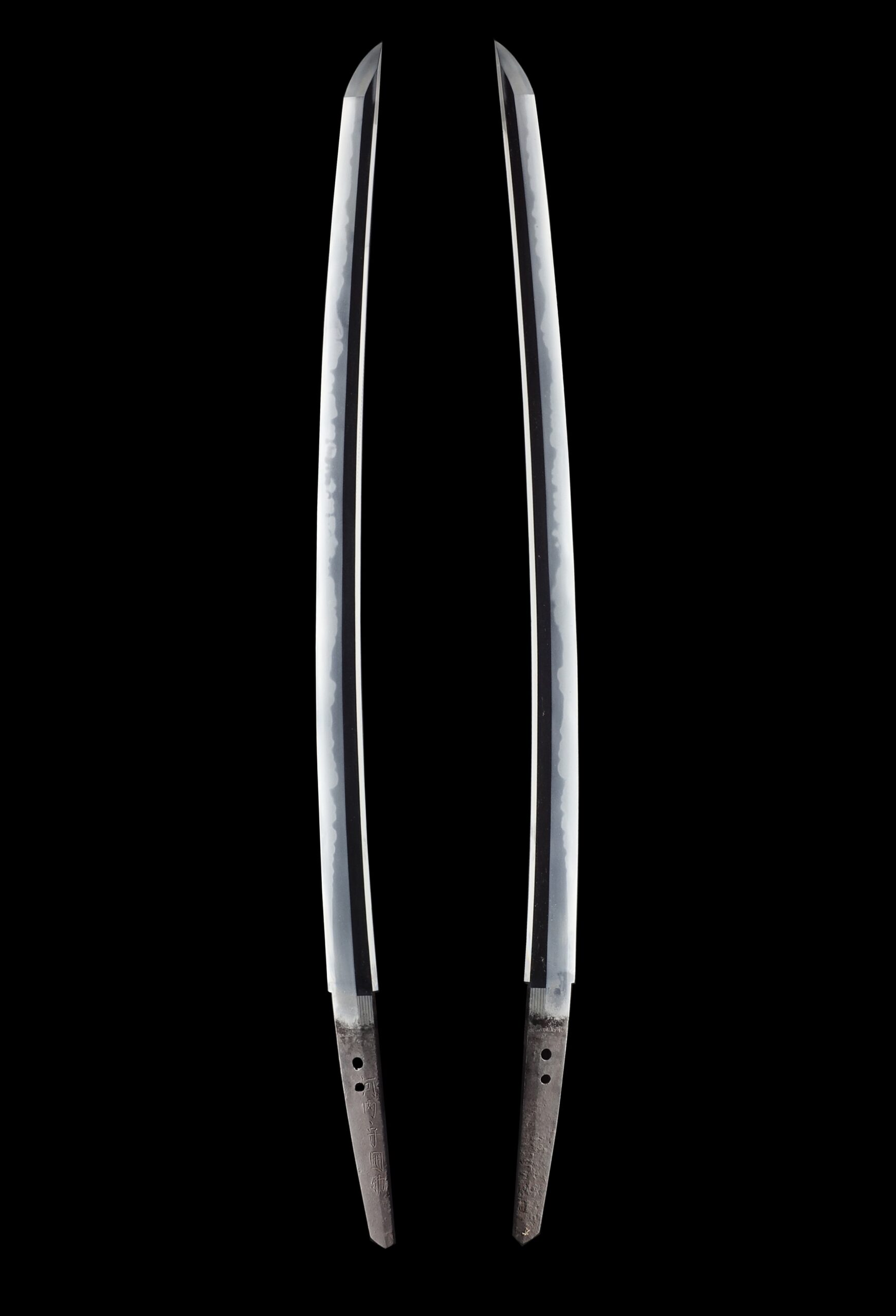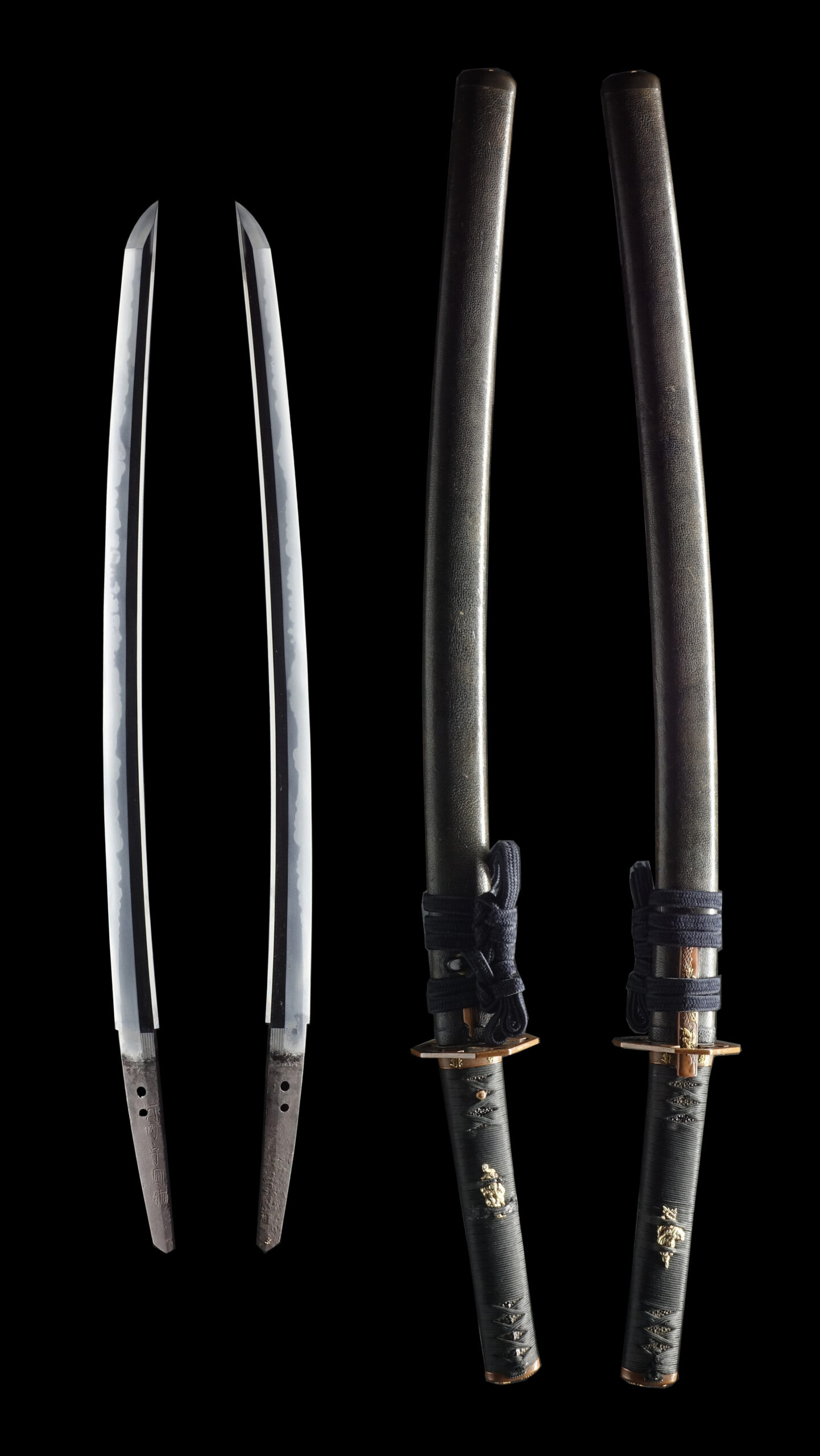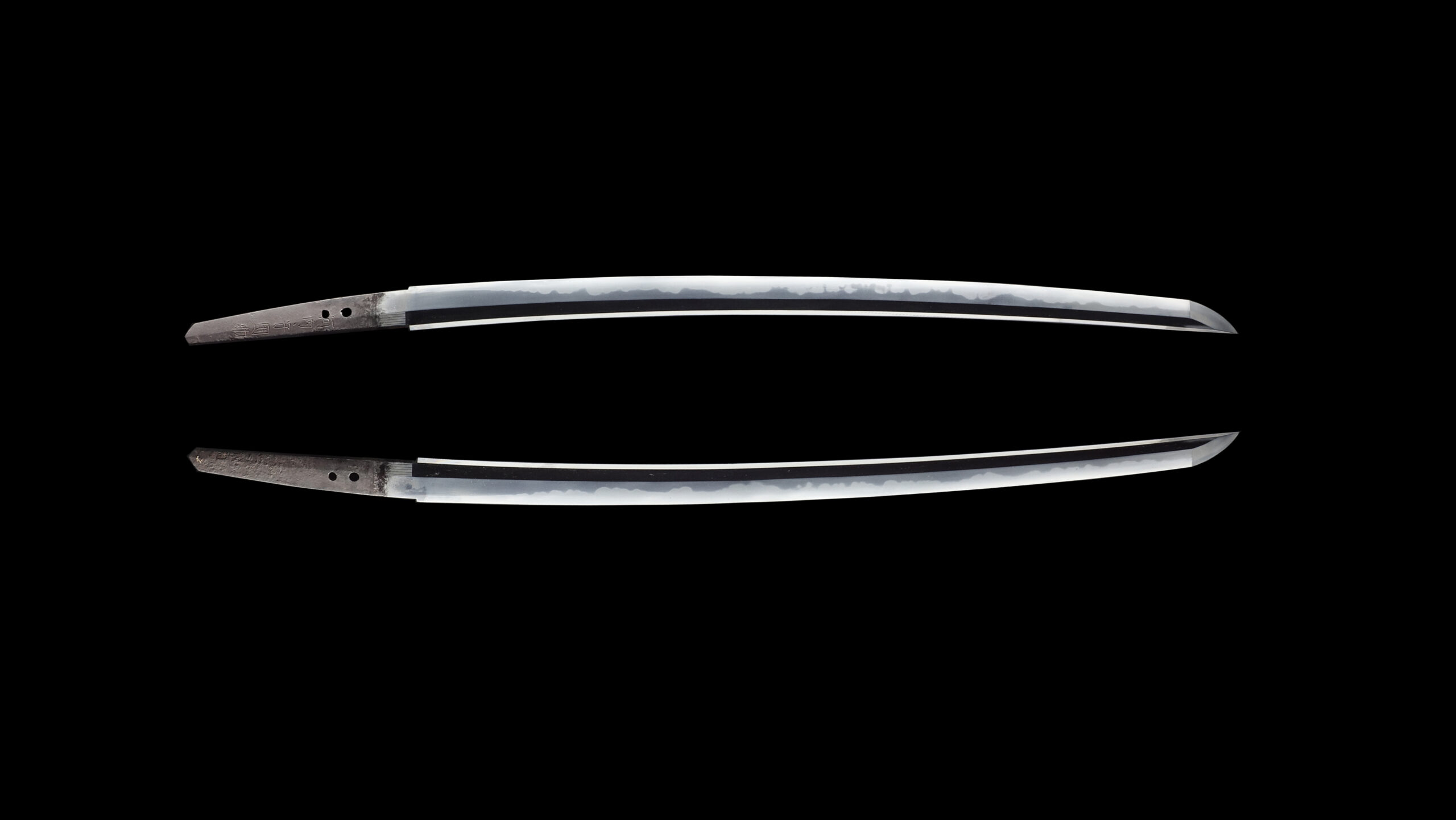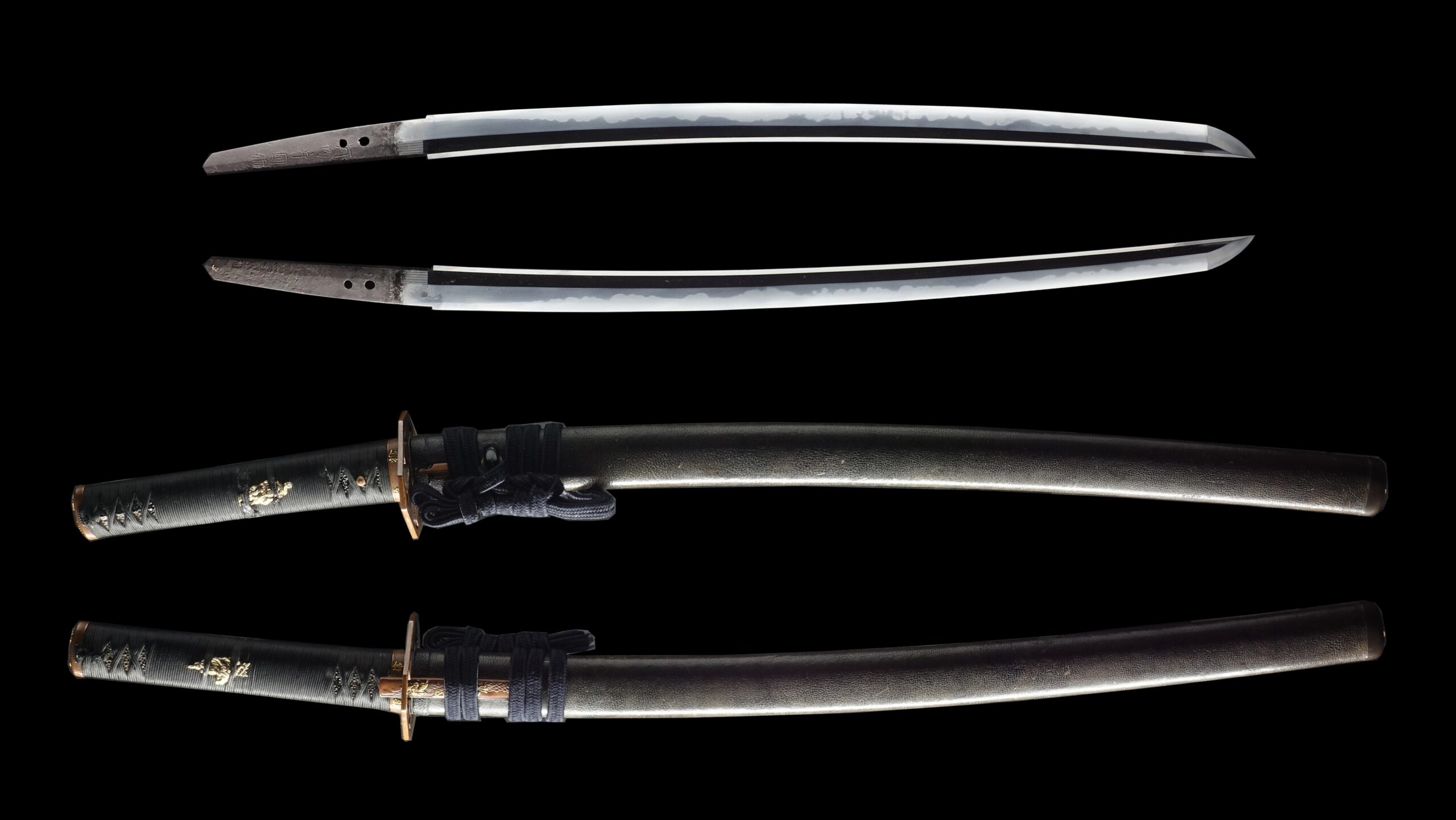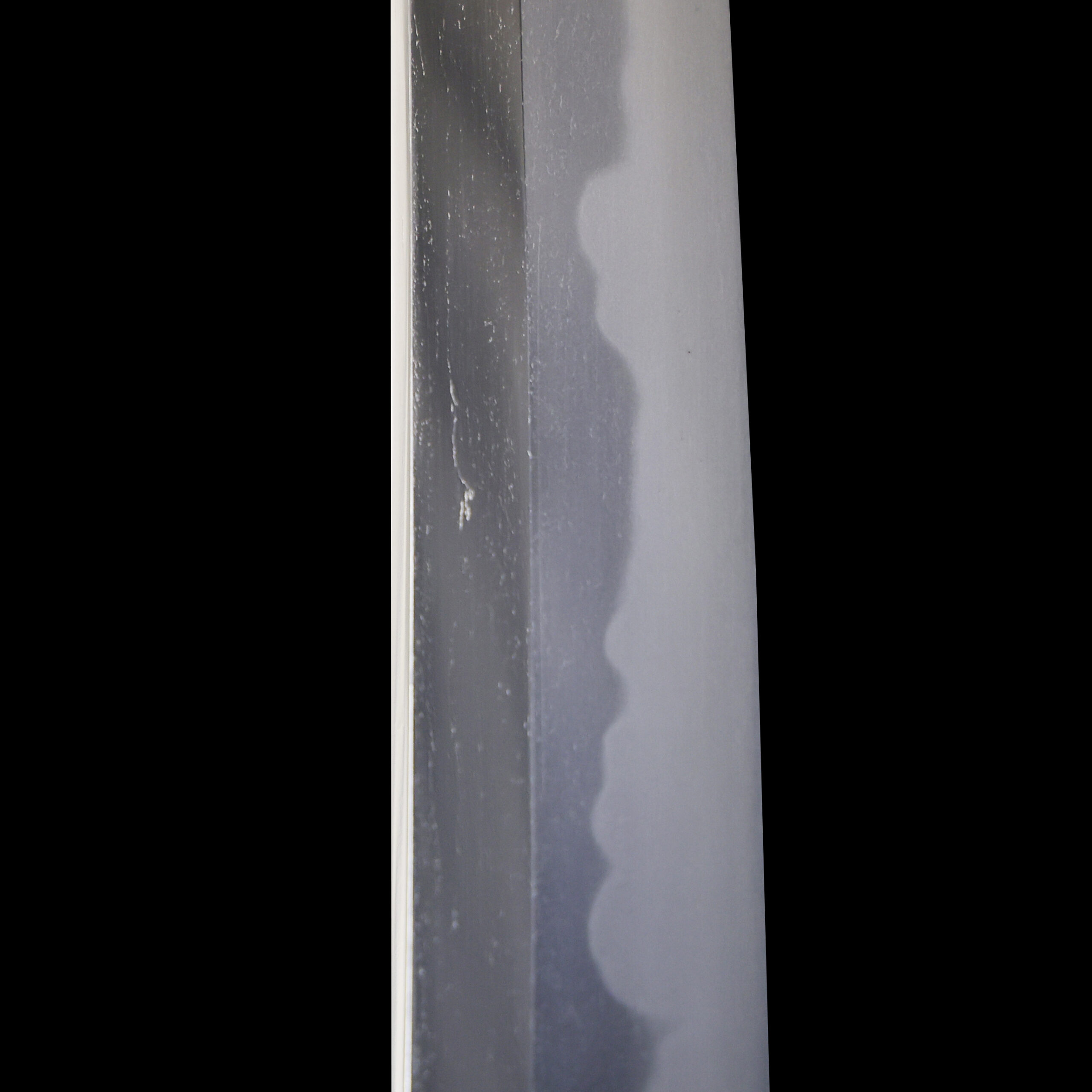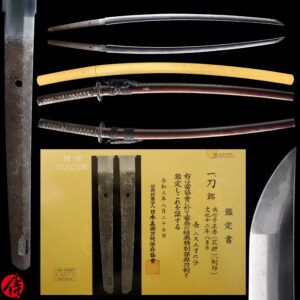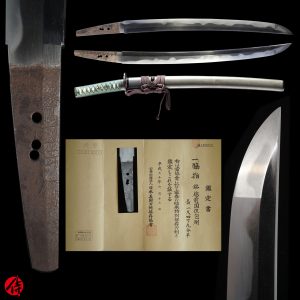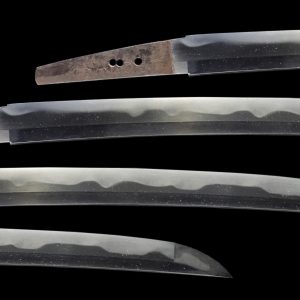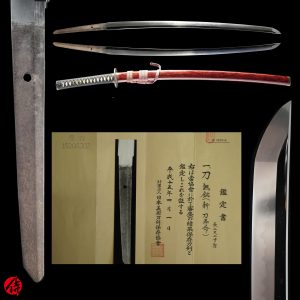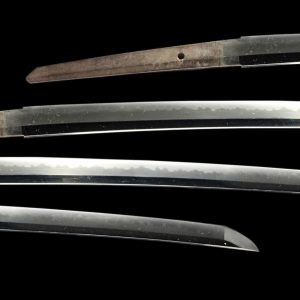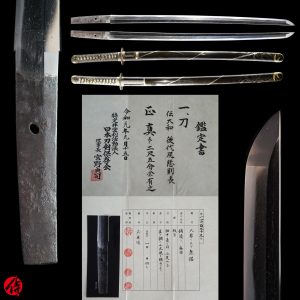Antique Japanese Sword Wakizashi Signed by Kunisuke with NBTHK Tokubetsu Hozon Certificate
【Description】
This wakizashi was forged by the third-generation Kawachi no Kami Kunisuke(三代 河内守国助), and has been authenticated as his work by the NBTHK (Society for the Preservation of Japanese Art Swords). The third-generation Kunisuke was a prominent swordsmith active in the early Edo period, and he forged swords in Osaka as the son of the second-generation Kunisuke, Kobayashi Rokunojo(小林六之丞). Because he also produced swords on behalf of his father as a daimei (代銘, substitute signature), swords signed by him as the third-generation Kunisuke are relatively few and therefore considered rare and valuable examples of his work.
The Kunisuke lineage is particularly known for the Kobushi Choji hamon (temper line), a pattern resembling a series of clenched fists (kobushi means “fist” in Japanese). This tempering style creates a bold, rhythmic pattern along the blade’s edge, symbolizing strength and vitality. The third-generation Kunisuke faithfully continued this tradition, and this blade features a fine example of the Kobushi Choji hamon.
The founder of the Kunisuke line, the first-generation Kunisuke, was originally from Ise Province (present-day Mie Prefecture) and served under Seki Kazumasa, the lord of Kameyama Castle. After the fall of the Seki clan, he moved to Kyoto and became a student of the renowned swordsmith Horikawa Kunihiro. Upon Kunihiro’s passing, he further refined his techniques under Echigo no Kami Kunitomo, and eventually moved to Osaka in 1630 with Izumi no Kami Kunisada, where he played a central role in establishing the Osaka Shinto sword-making tradition. His skill and legacy were passed down to his descendants, including the third-generation Kunisuke who forged this blade.
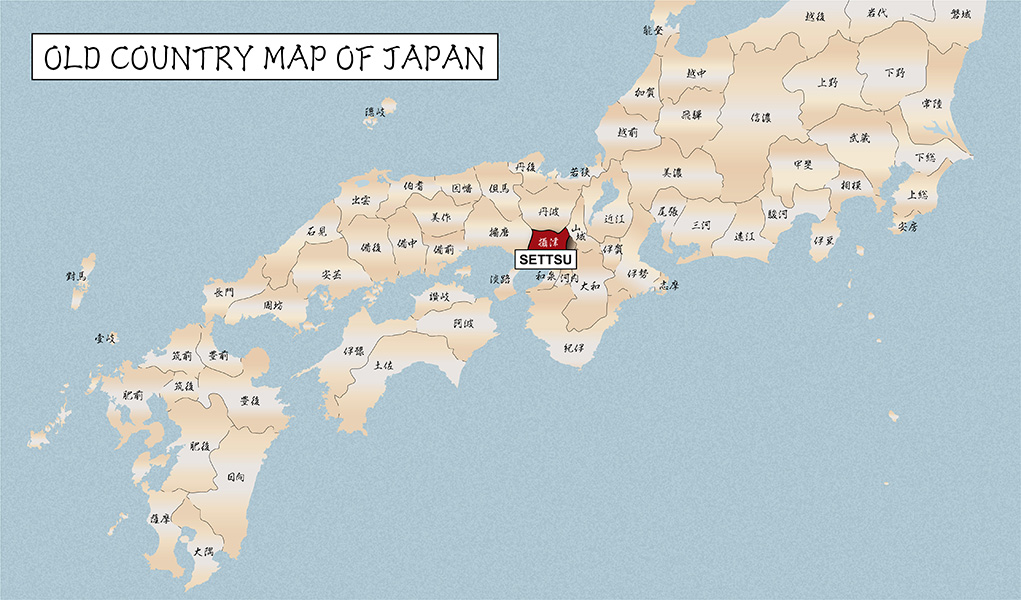
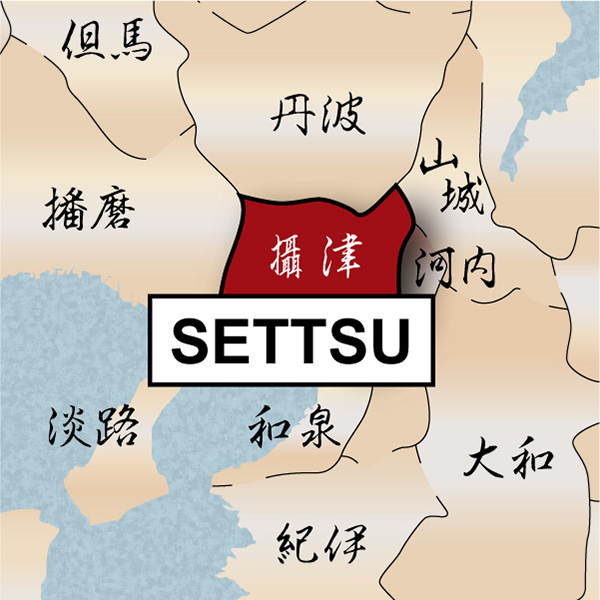
It is appraised as a Tokubetsu Hozon Token (特別保存刀剣) issued by NBTHK (Nihon Bijutsu Touken Hozon Kyokai: 日本美術刀剣保存協会). This authentication paper was only given to authentic Japanese swords, especially well preserved and high quality with artistic value.
【Blade】
Cutting Edge Length (Nagasa): 58.0 cm (22.8 inches)
Curvature (Sori): 1.2 cm (0.47 inches)

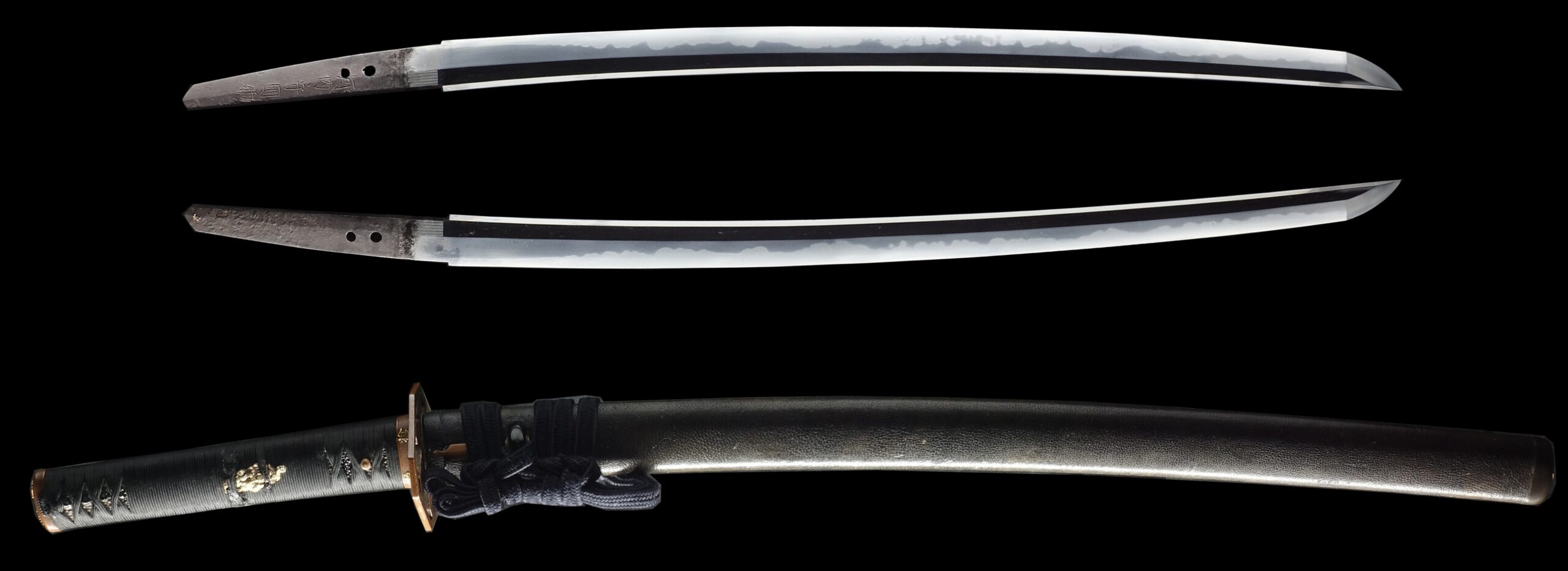
Hamon:
The crystalline structure which forms along the cutting edge of a blade as a result of the hardening process.
Jimon(Jihada):
visible steel surface pattern created by folding and hammering during forging process
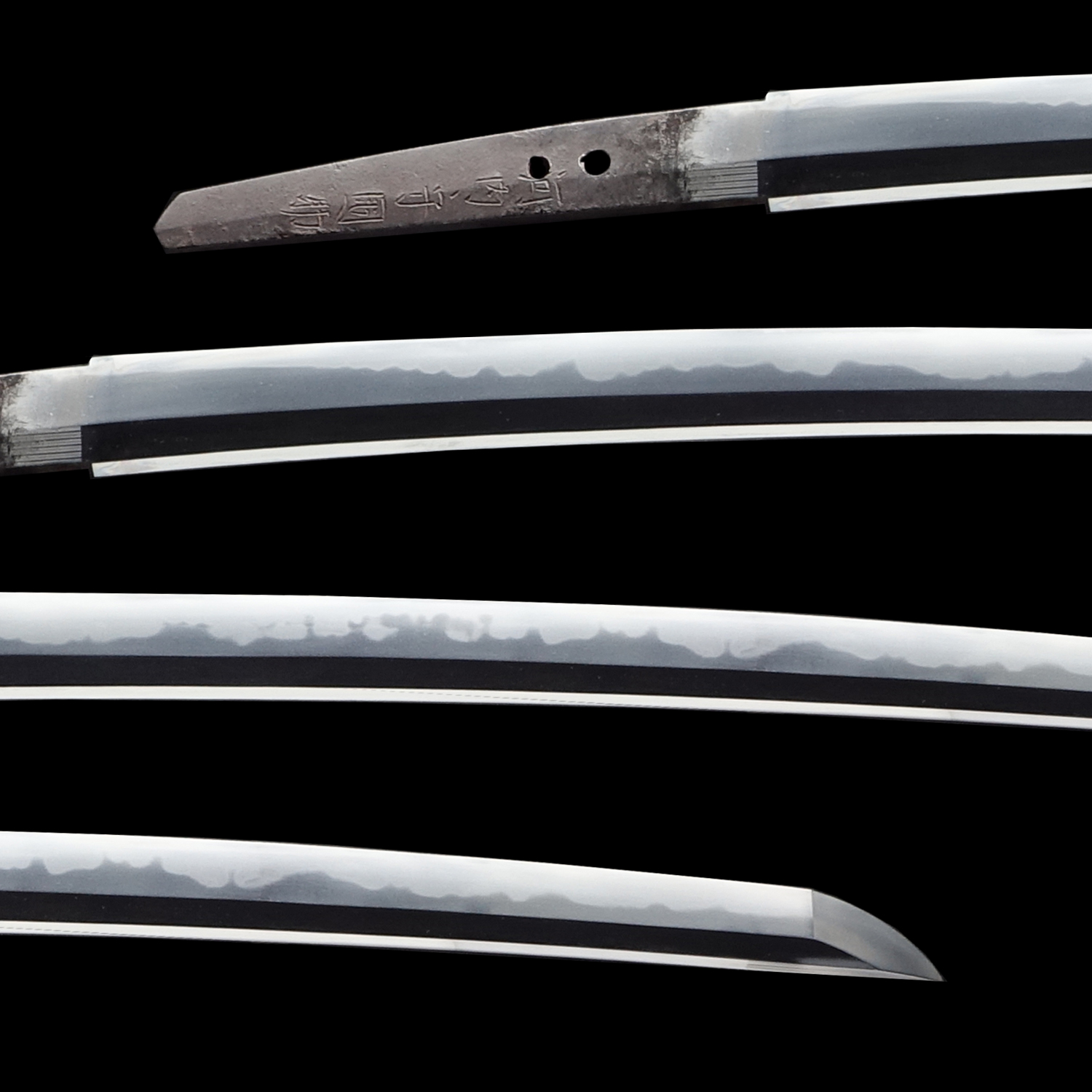
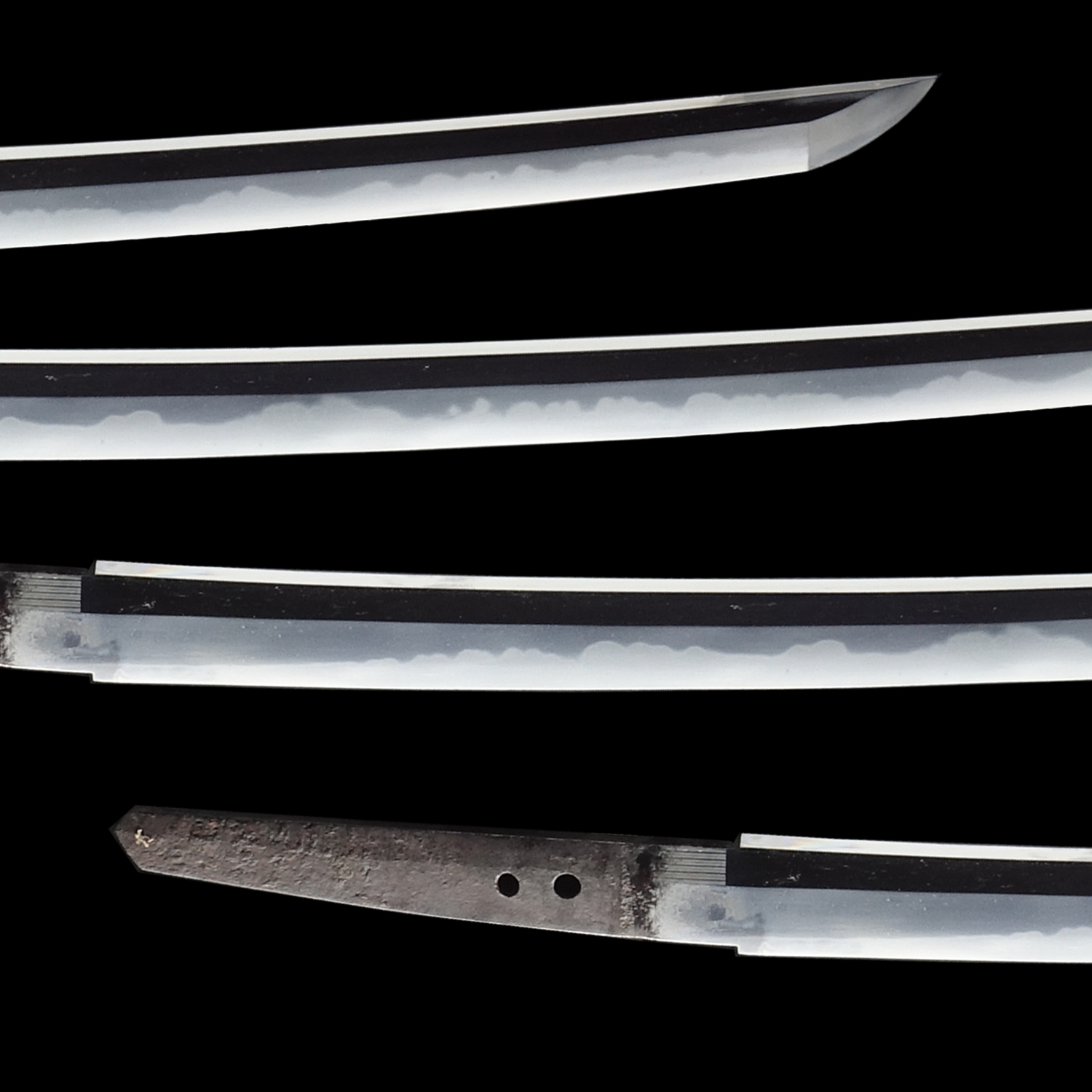


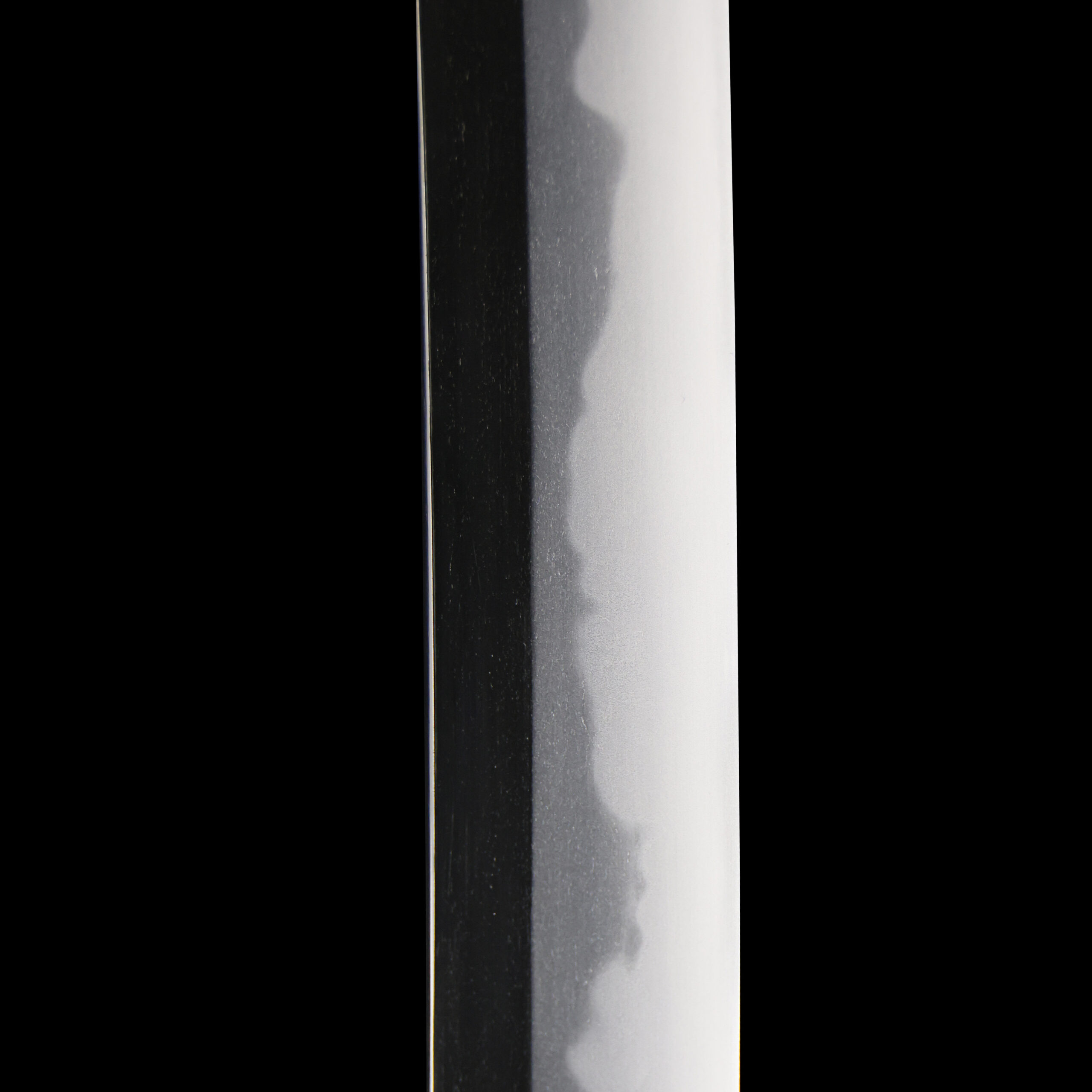
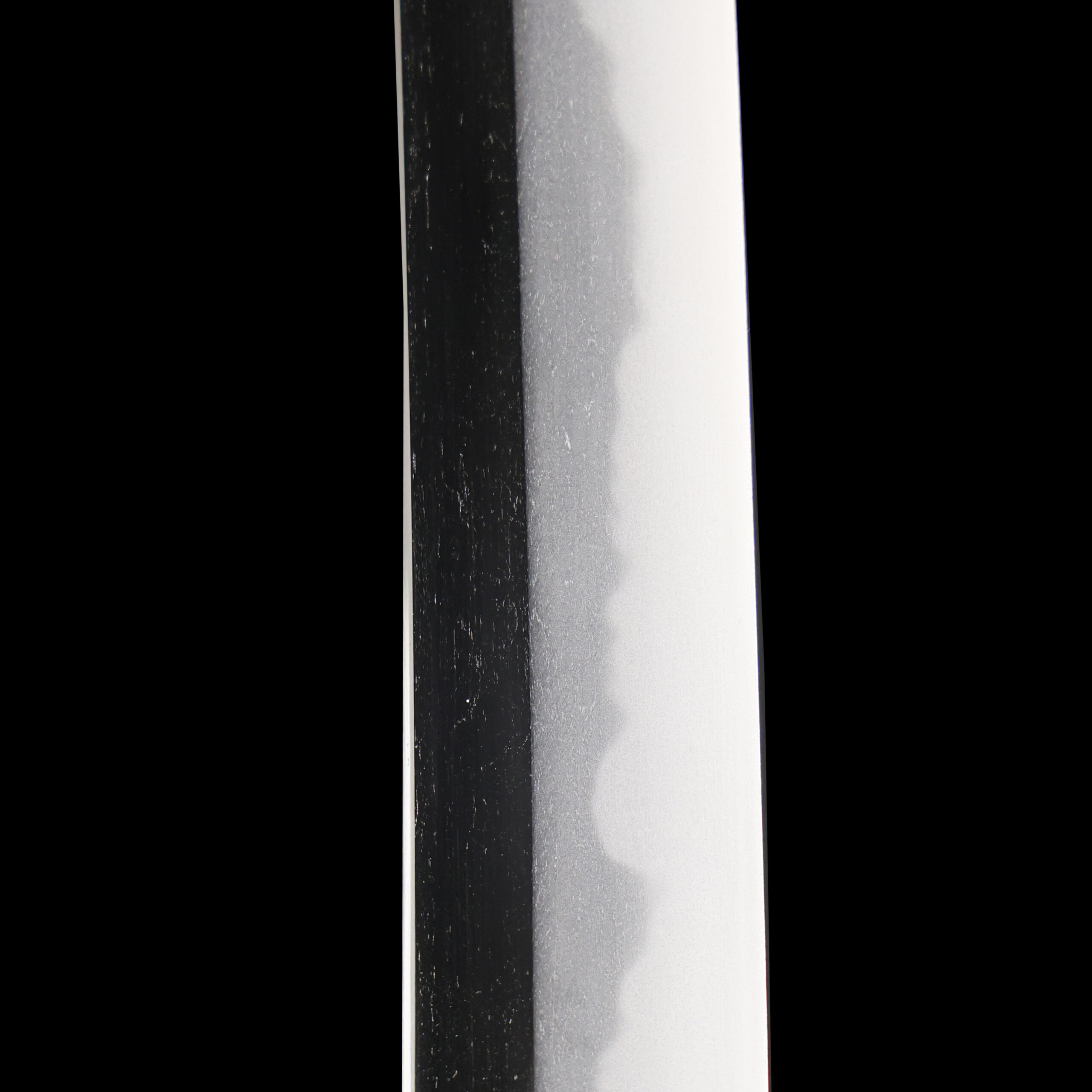
Kissaki: Kissaki is the tip of the Japanese sword.
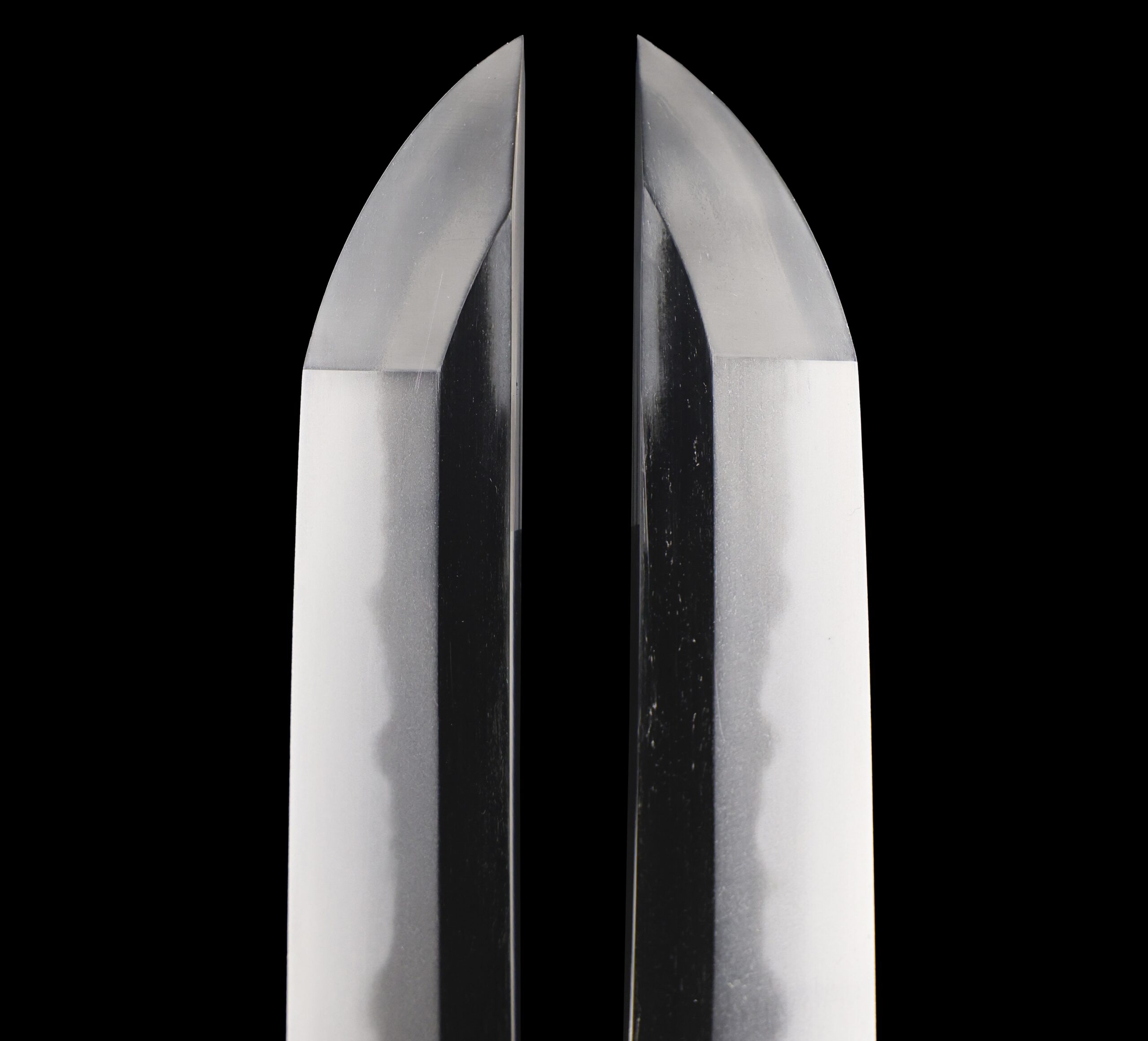
Nakago: Nakago is the tang of the Japanese sword.
Japanese swordsmiths left the black rust on the tang because it prevents red rust while the tang is in its handle. And the discoloration of the tang was created over time, and it is a great indicator for a Japanese sword specialist to estimate when the sword was forged.

Koshirae:Koshirae is the mounting of the Japanese sword. There are several parts that consist of Koshirae such as Saya (Scabbard), Tsuka (Handle), Tsuba (Handguard).
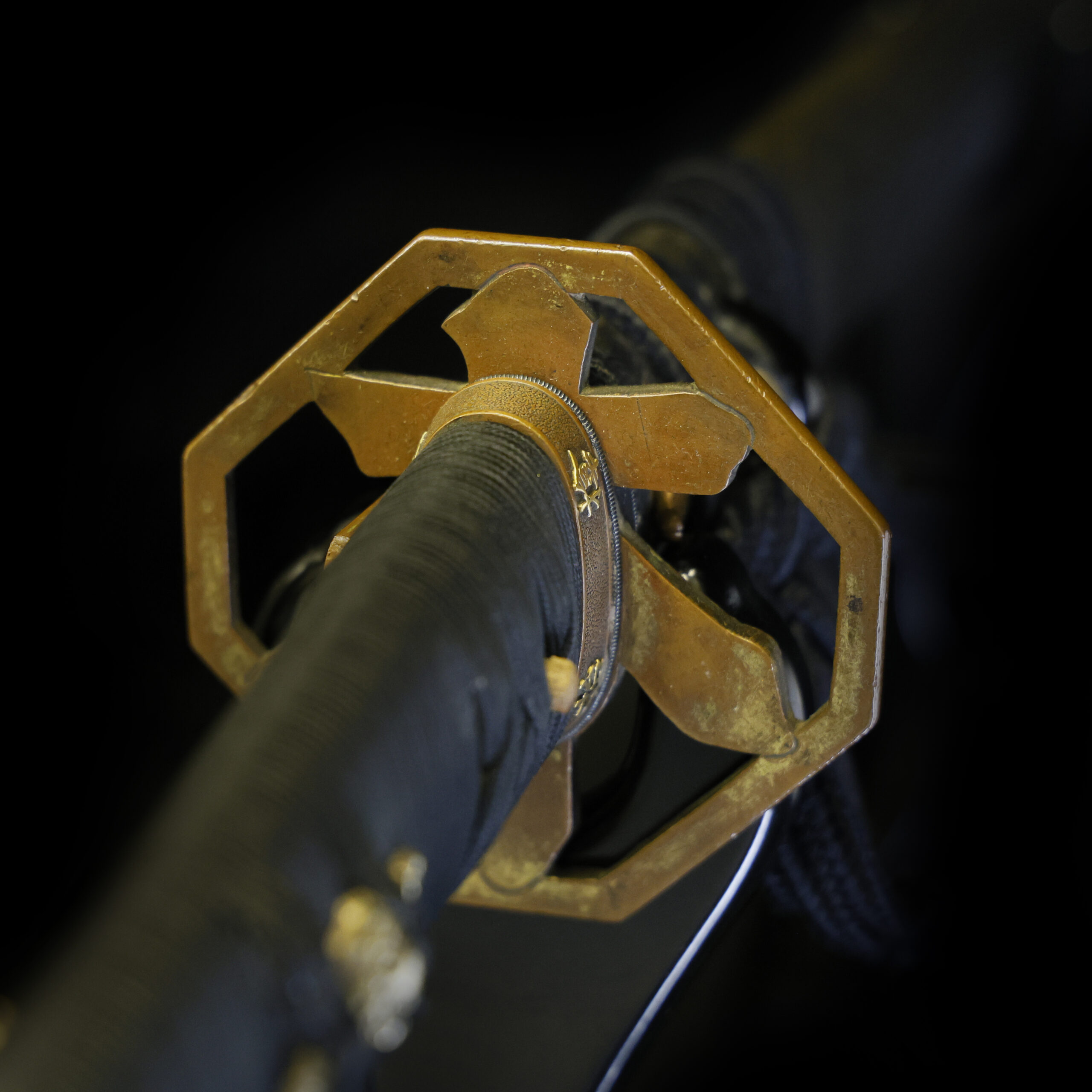
Fuchi-Kashira:A pair of matching sword fittings that cover the upper and bottom parts of its sword hilt.
On the fuchi (metal collar between the blade and handle) of this sword’s fittings, there is an engraving of the sacred characters (神字, shinji) known as “Samuhara” (サムハラ).
Interestingly, the original form of “Samuhara” is composed of four unique symbols that resemble kanji but are actually sacred characters—not standard Chinese characters. Each character contains the radical for “hand” (扌), and together they are said to symbolize protection from illness, accidents, and misfortune, as well as longevity and well-being. These characters are considered talismanic in themselves and have long been used as spiritual symbols of protection. Because the original sacred characters are extremely rare and cannot be typed or reproduced with ordinary fonts, they are commonly written phonetically in katakana as “サムハラ.”
Additionally, the kashira (pommel cap) is inscribed with the word “Hakuchi” (白雉), which refers to a Japanese era name from the Asuka period (circa 650s AD). It can also be interpreted as a symbolic reference to auspiciousness, purity, or historical prestige.
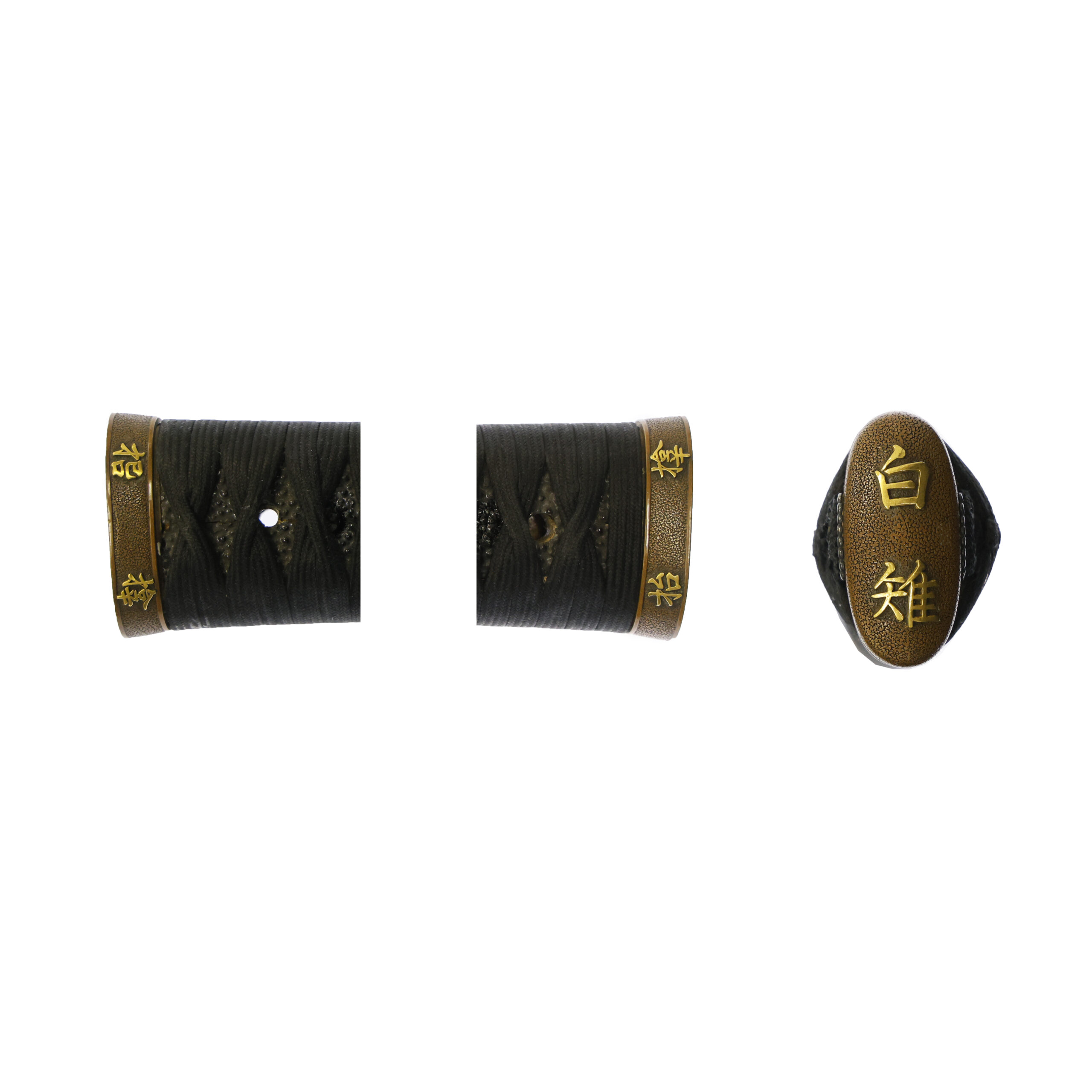
Tsuka and Menuki: Tsuka is the handle of the Japanese sword and Menuki is its decoration.
The motif of this Menuki is Shishi-botan (獅子牡丹, the lion and the peony), which is a combination of Karajishi (唐獅子, lion) and Botan (牡丹, peony). While lions have been known as the “king of beasts”, peonies have also been called the “king of flowers.” Therefore, this combination motif has been favored since ancient times.
The Shishi (獅子) means a lion in Japanese, and the Karajishi is a lion brought from the continent to Japan in the Toh period (唐, Tang dynasty, 618-907). The Karajishi typically has curly hair for its head, neck, body, and tail, as seen on this work. In Buddhism, the Karajishi is regarded as a symbol of wisdom, and Monju Bosatu (文殊菩薩, Manjushri Bodhisattva) rides lions. According to a theory, the Karajishi is the origin of Komainu (狛犬, stone guardian dogs that exorcize evil spirits). It shows this animal motif has been familiar to Japanese people since ancient times.
There is a Houwa (法話, Buddhist monks tell the story of Buddhism in an easy-to-understand manner) that treats the Karajishi and this flower. The lion is called the king of the beasts. However, even this invincible animal has only one fear: a bug in the lion’s body. This pest grows in the lion’s hair and eventually breaks the skin and bites the flesh. Nevertheless, it dies if it is exposed to the night dew of a peony. Therefore, the lion rests under peony flowers at night, looking for a haven. The design of these sword mountings might have been quoted from this story.

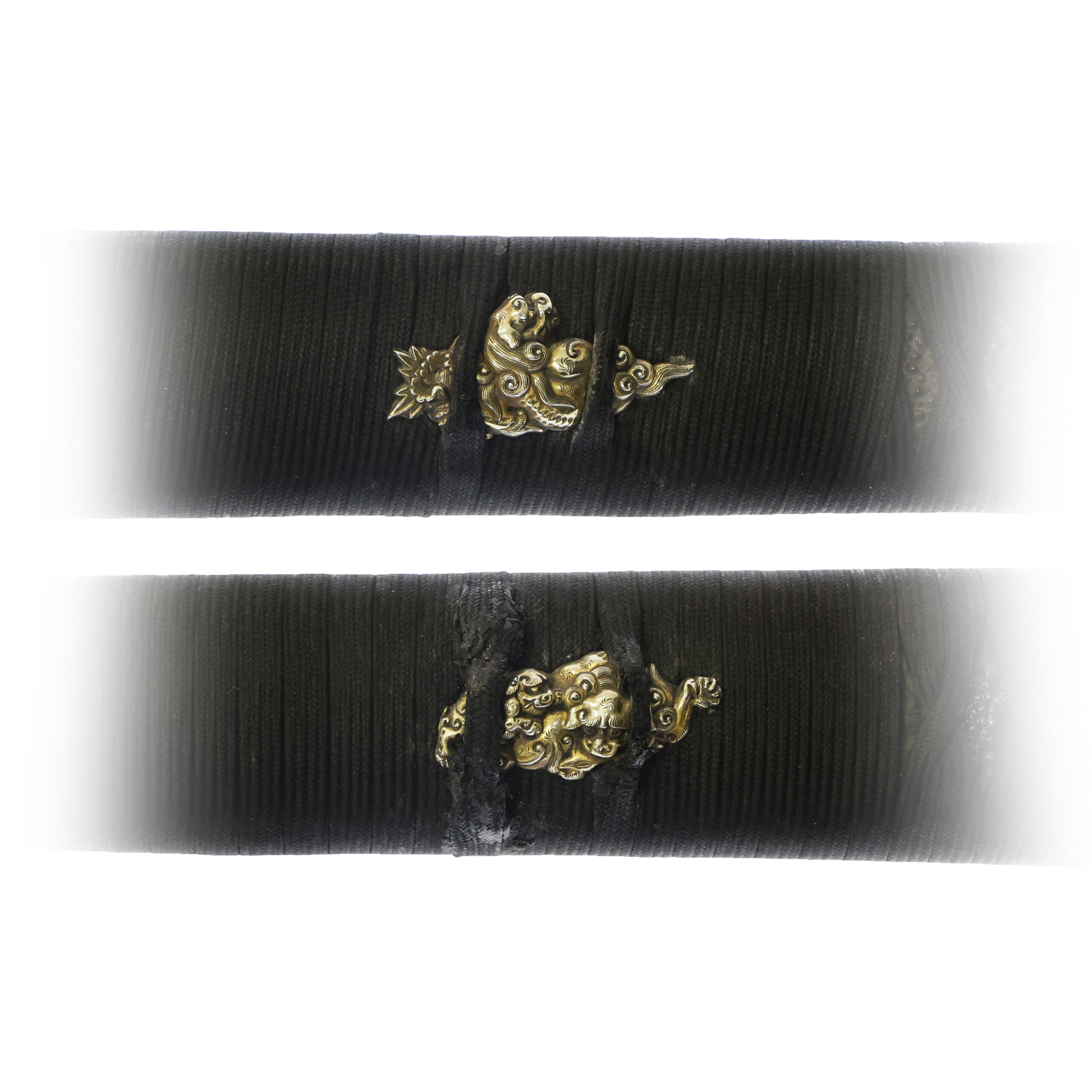
Tsuba and Habaki: Tsuba is the handguard for the Japanese Sword and Habaki is the equipment to make the blade not touch its scabbard inside. It prevents the blade from getting rusty and chipped.
This tsuba (sword guard) features a distinctive design using the technique of openwork carving (透かし彫り, sukashi-bori) to depict the Chinese character “木”, which means “tree” or “wood” in Japanese. The character “木” is not only a basic kanji but also a symbol of nature, life, and growth in Japanese culture. Trees have long been revered in Shinto and Buddhist traditions as sacred objects that embody spiritual energy and longevity. The use of this character in the tsuba’s design may reflect the sword owner’s desire for stability, vitality, or a deep connection with nature.

Kozuka:Kozuka is a small knife stored in Kozuka Hitsu(groove of the sheath of the Japanese sword).
The theme of this Kozuka is the Genpei Kassen (源平合戦). It is also called the Jishou Juei-no Ran (治承・寿永の乱) and stretched over six years from 1180 until 1185. This is the battle between the Minamoto (源) clan (Genji family) and the Taira (平) clan (Heike family). By Mochihito Ou’s (以仁王) call, many Samurai warriors raised armies to overthrow the Taira family. It was the trigger of this protracted conflict. Mochihito Ou was unfortunately beaten by the Taira family and passed away in 1180. However, after that, the Minamoto family side Samurai warriors defeated the Taira side armies one after another. Finally, the Minamoto side won the battle and overthrew the Taira clan in 1185 at Dan-no Ura (壇ノ浦). It was the final battle of the Genpei Kassen, which led to the destruction of the Taira clan, who reached the height of glory.

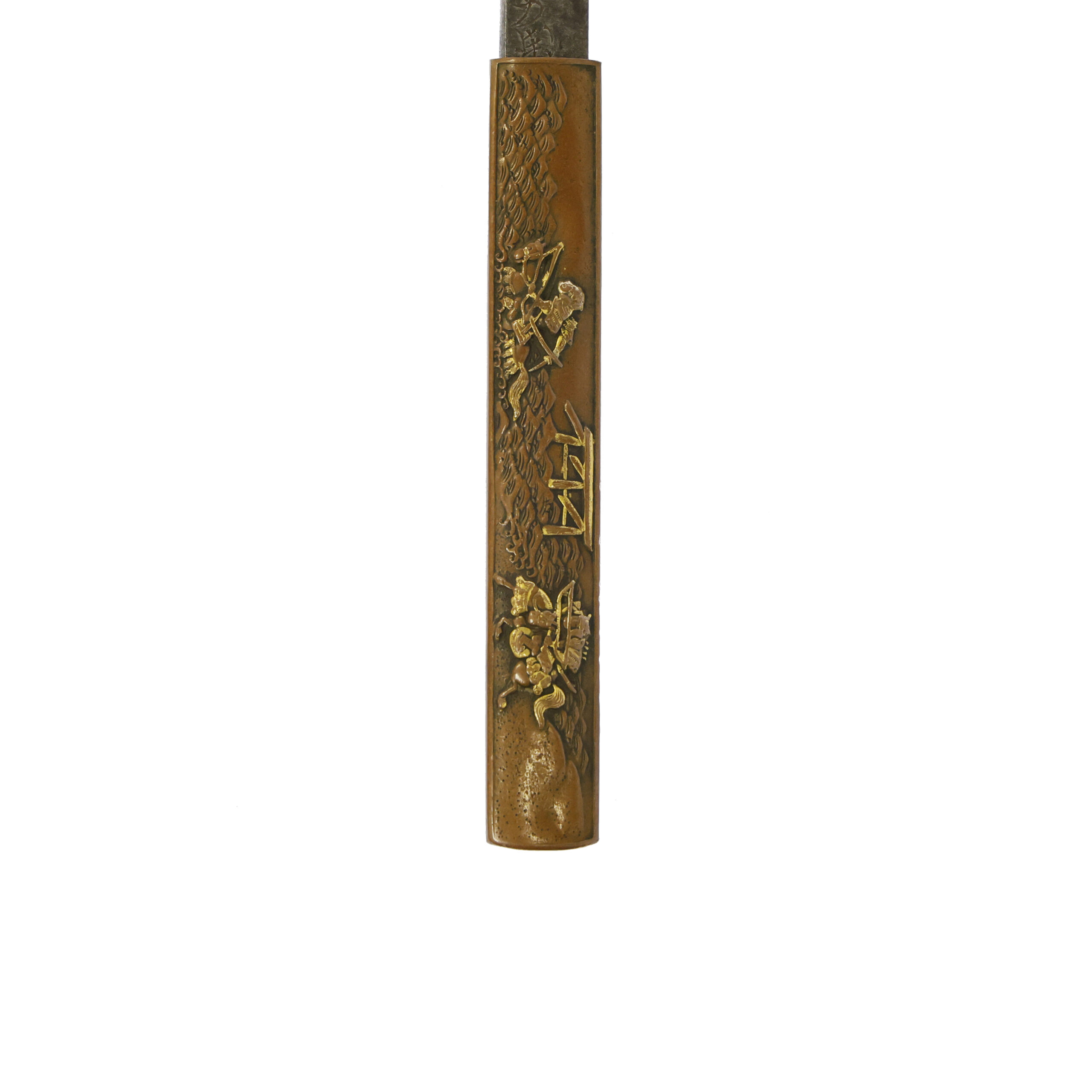
Kougai:Kougai is the equipment for Samurai to arrange or fix his hair style.
This item is an antique Kougai (笄), which was used to arrange or fix the hairstyle of Samurai. The Kougai is usually stored in the Kougai Hitsu. The Kozuka (小柄) is often stored at the other side of the scabbard.

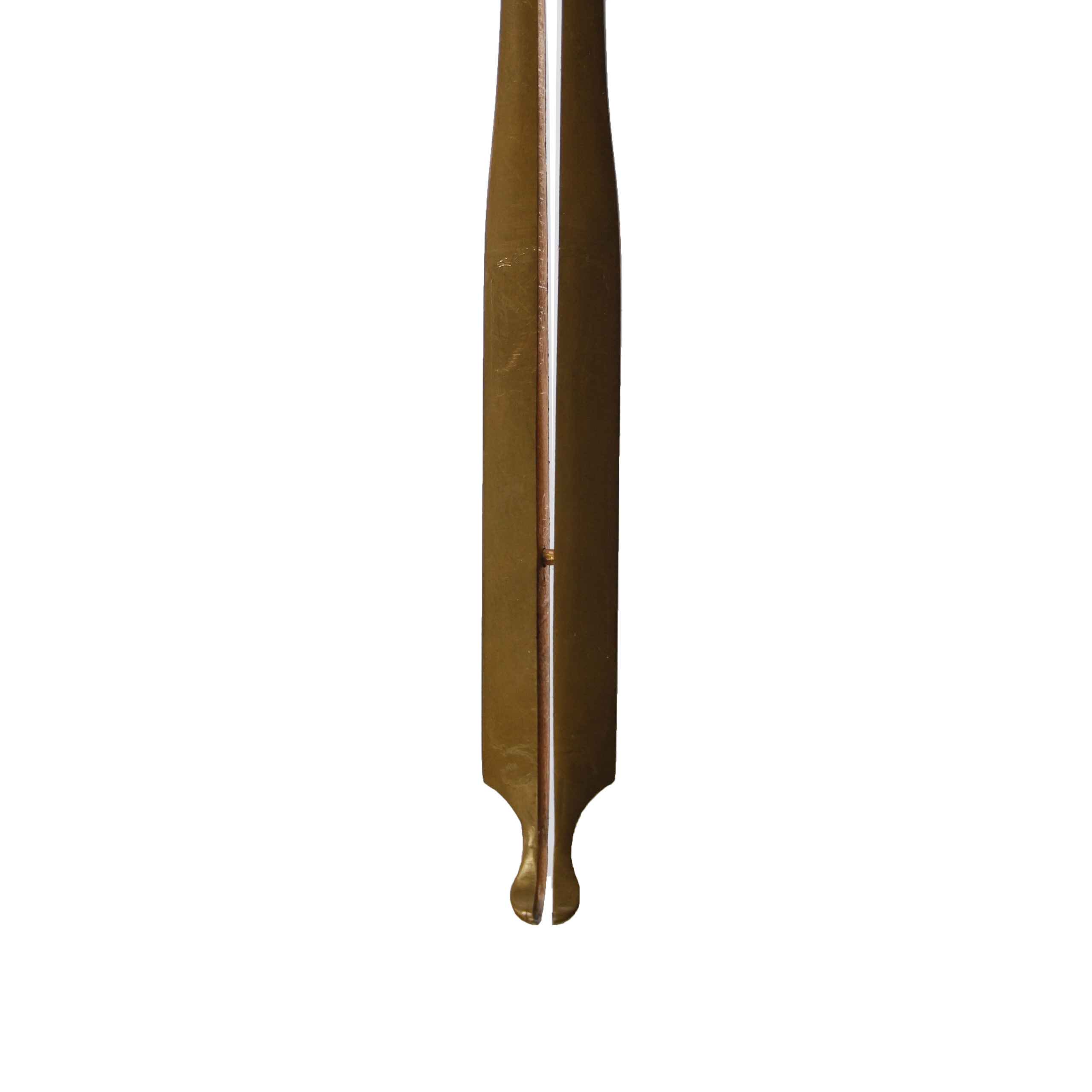
Saya: Saya is the scabbard for the Japanese sword.
*While the blade is categorized as a Wakizashi, it comes with a Katana size Saya (scabbard).
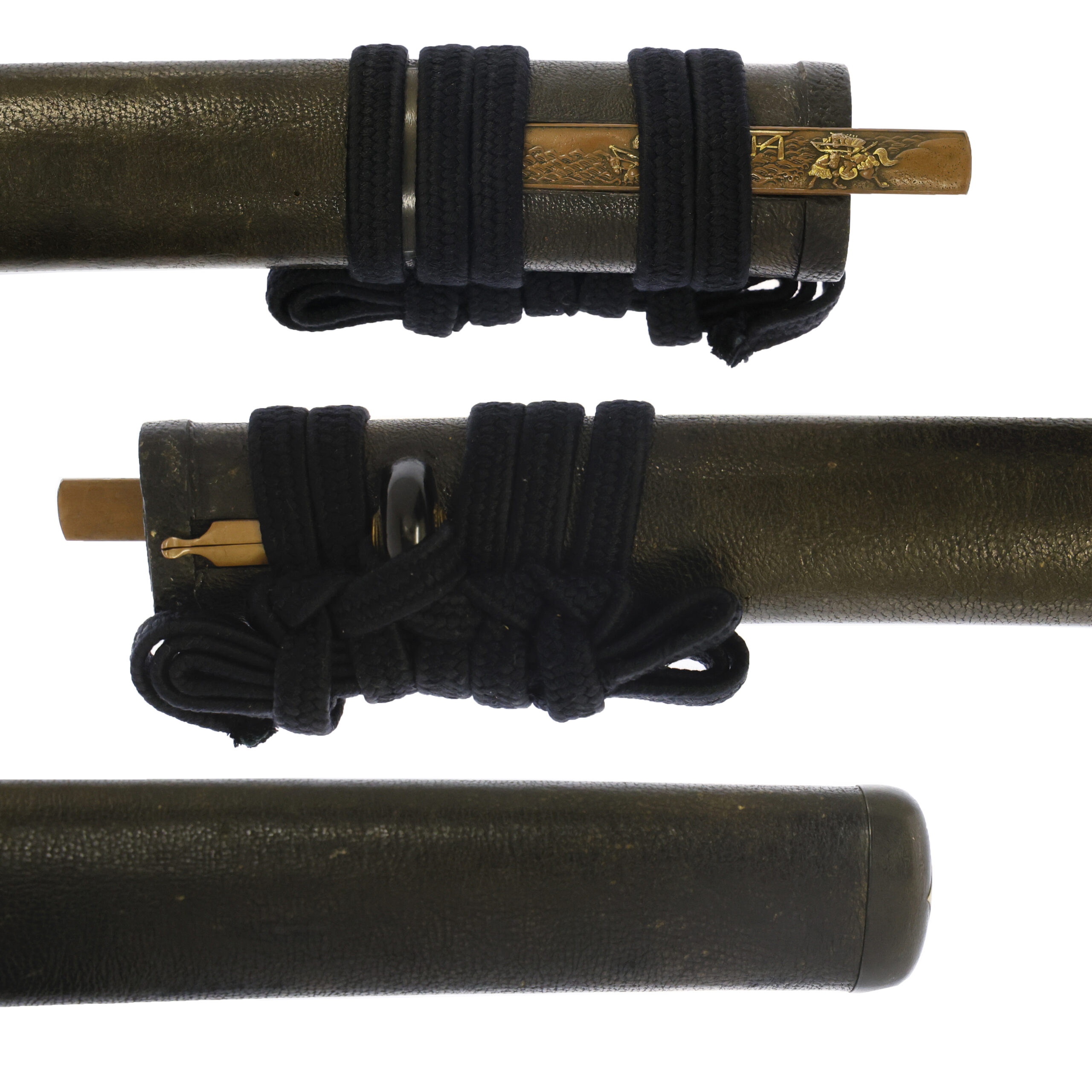
Authentication Paper: NBTHK TOKUBETSU Hozon Certificate for the blade (No. 1021296)
NBTHK, also known as Nihon Bijutsu Touken Hozon Kyokai (the Society for the Preservation of the Japan Art Sword), is one of the oldest Japanese sword appraising organizations in modern-day Japan. They authenticated the blade on August 25th in the 5th year of Reiwa (2023). They appraised it as Tokubetsu Hozon Touken, the blade especially worth preserving for Japanese society. The purchaser will receive this original certificate as well. We can also translate what is written into English and make a PDF file for your record if you request.
*Please keep in mind that the registration number shown on this certificate is different from its current registration number. This is because the blade was re-registered after the certificate was issued on August 25th in 2023. The registration was re-issued on October 18th in 2024. As you can see the signature, the shape of the Nakago and the location of the Nakago hole on the certificate are identical to that of this blade.
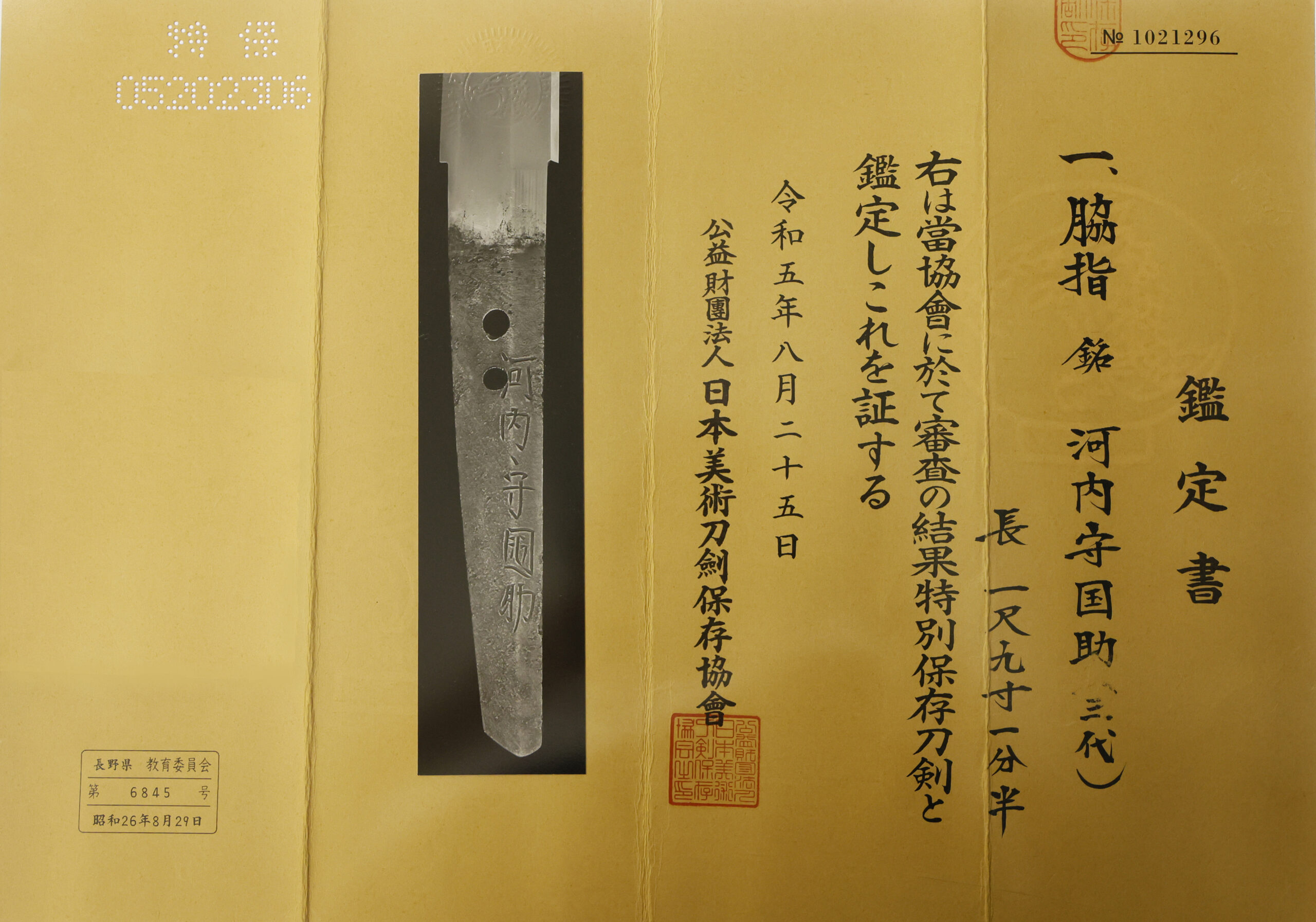
Registration Number: Tokyo 328656
The Board of Education in Tokyo issued a registration paper for this sword . It is called Jyu Hou Token Rui Tourokusho (銃砲刀剣類登録証). Bunkacho (The Agency for Cultural Affairs) acknowledges a Japanese sword with this paper as a work of art.
The sword needs to be traditionally hand-forged and made of Tamahagane carbon steel to be registered in the system. With this paper, its owner in Japan can legally own an authentic Japanese sword. Based on this registration number, we will apply for its export permit.
This paper will need to be returned to the board of education when the sword is being shipped abroad, but you can receive a copy of it. An English translation of this registration paper is available on request.


【About us】
Samurai Museum is located in Tokyo, Japan, exhibiting antique artifacts related to the Samurai history. Samurai Museum Shop is the place for those who are interested in Japanese culture and craftsmanship. We deal with antique Samurai swords/armor, traditional crafts made in Japan and so on.
【Japanese Sword& Export Process】
The Japanese swords we deal with are hand-forged edged swords made in Japan. It was made from the traditional carbon steel called TAMAHAGANE(玉鋼). Samurai Museum is familiar with the proper legal procedure for an antique/ authentic Japanese sword to be exported from Japan. We have sent more than 1000 Japanese swords for the past few years (~2025) to amazing owners who appreciate its historical value.
Each Japanese sword is registered under the Agency for Cultural Affairs and the Board of Education in Japan. They issue a registration paper for each Japanese sword for its owner in Japan to legally possess it. The Japanese sword with its registration paper means it was traditionally hand-forged in Japan.
To legally export the sword from Japan to other countries, we will have to apply for its permit to the Agency for Cultural Affairs(Bunkacho) and return the original registration paper to the Board of Education. It normally takes around 2-4 weeks to receive this permit after submitting required documents. And we would like you to expect at least 1-1.5 months for your order to arrive at your given address after you ordered. For more detailed info, please click here.
It is allowed for residents in Japan to own authentic Japanese swords without a special license as long as they come with registration papers. Please feel free to contact us if you are a resident of Japan, whether temporarily or permanently. We will also assist you when you leave Japan and need to obtain the export permit.
【Payment Method】
We accept payment through Stripe (Credit card), PayPal, Apple Pay or ChromePay, all of which are secure payment methods. Also, you don’t need to make an account on Stripe for the checkout. If you prefer other payment method, please contact us. After confirming your payment, we will apply for an export permit. You may either pay in JPY, USD, AUD, CAD,EUR CHF or GBP. The price is set in Japanese Yen. Prices in other currencies are automatically calculated based on the latest exchange rate.

* If the amount is above 1 million JPY, Stripe or wire transfer will be the only options for payment.
【Shipping】
We have shipped authentic Japanese swords to the USA, UK, Canada, Mexico, Germany, France, Hong Kong UK, and Australia. If you don’t live in these countries and like to order, please contact us first before making a purchase. We offer Free International Shipping as long as we can send antique Japanese swords by EMS.
We normally ship by EMS(Express Mail Service) provided by Japan Post. We will send you a tracking number for your order as soon as we hand it to the post office. We will put 100 % insurance on the shipping document without any extra charge. Based on the total amount, there might be a duty tax or other fee for you to pay, depending on the countries. We use package cushioning to protect the item and put it in a PVC pipe, which is one of the most secure packages because of its durability.
It will normally takes 5-14 days for the item to arrive at your given address after we dispatch it. Time of delivery is estimated as accurately as possible by the carrier but does not take into account any delays beyond our control such as by inclement weather, post office holiday seasons.
* If you live in Australia and like to purchase an authentic Japanese sword, please click here to know the detail.

【Review】
Here is one of the reviews we received from a customer who purchased an authentic Japanese sword from us. For more reviews, please click here.
“My experience overall with the whole process was wonderful. I had many questions about the history and process to purchase these treasures. All my questions were answered very timely and complete. The staff is very knowledgeable and very well versed if any questions do arise.”
【How to make sure the condition】
Please keep in mind that what you are going to purchase is an antique item. We uploaded high resolution photos for you to check its condition thoroughly. If you like to see more photos with different angles, please feel free to contact us. We will be happy to send them to you so that you can make informed decision. It is essential for us to know that you are happy with your choice of a sword. and we are prepared to use the best of our ability to serve you.
【How To Contact Us】
Please contact us through email, Facebook Messenger or Live Chat if you have any questions. You can find each icon on the right side of the website. Please click one of them to reach us. We will reply to you within 1-2 business days.
【The Art of Nihonto (Japanese Sword)】
Samurai’s history is a profound, eloquent legacy of ancient Japanese warriors in which millions of people worldwide are being fascinated. If you like to find out the art of Nihonto, please click here.
【A Guide to Japanese Sword Maintenance】
After acquiring an genuine Japanese sword, it is also important to know how to take good care of it. Here is the special video for you. Mr. Paul Martin, Japanese sword expert, shows you how to give proper maintenance to your sword. By mastering how to clean the Japanese sword, its aesthetic beauty will last forever.
When you purchase a Japanese sword from us, you can get a Free Japanese sword maintenance kit. It comes with four tools(Choji Oil, Uchiko Whetstone Powder, Peg remover, Oil Applicator). By watching the video instruction above , you can enjoy learning how to maintain your Japanese sword while appreciating it. If you have any difficulty assembling the sword or cleaning the blade, you can feel free to contact us.
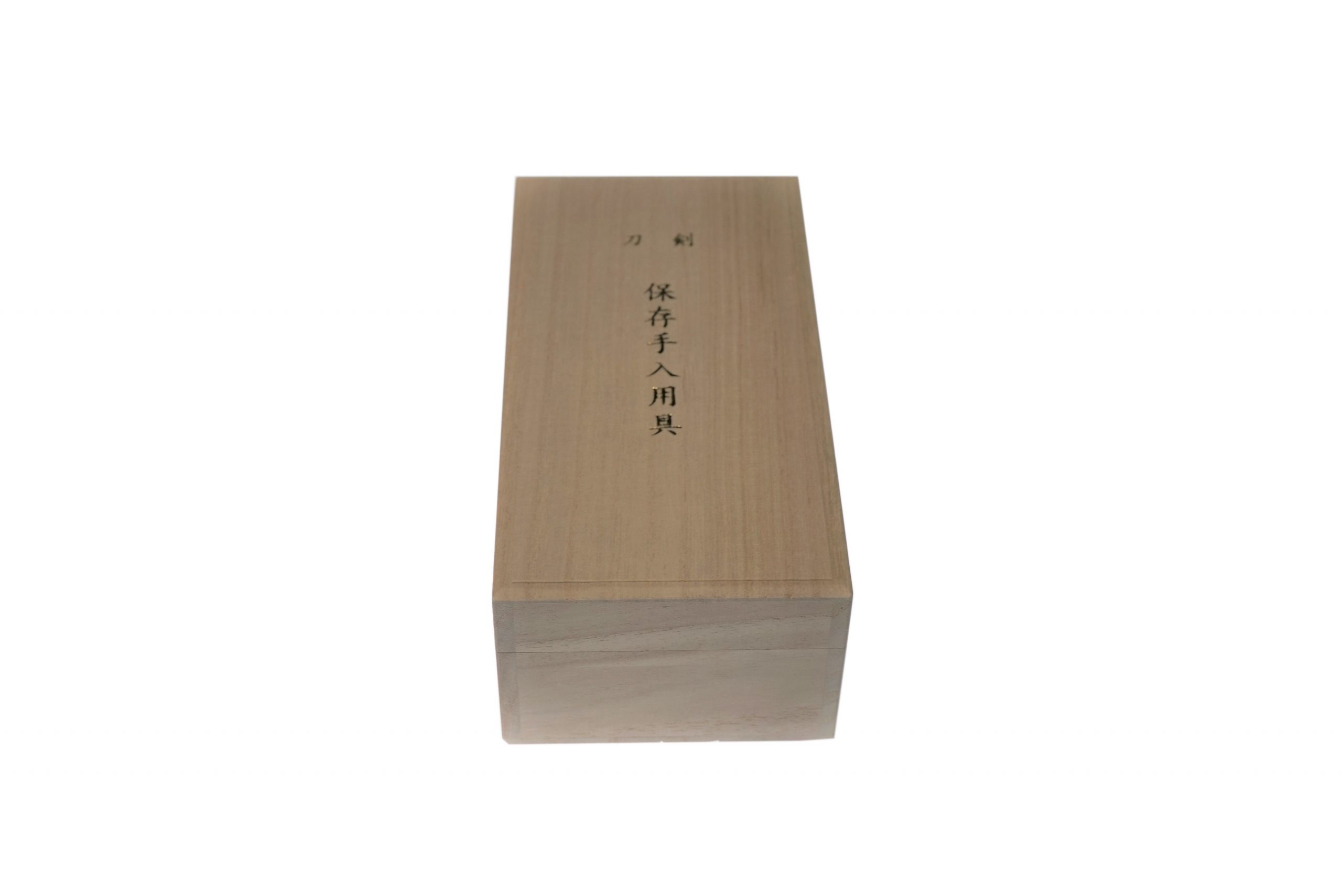
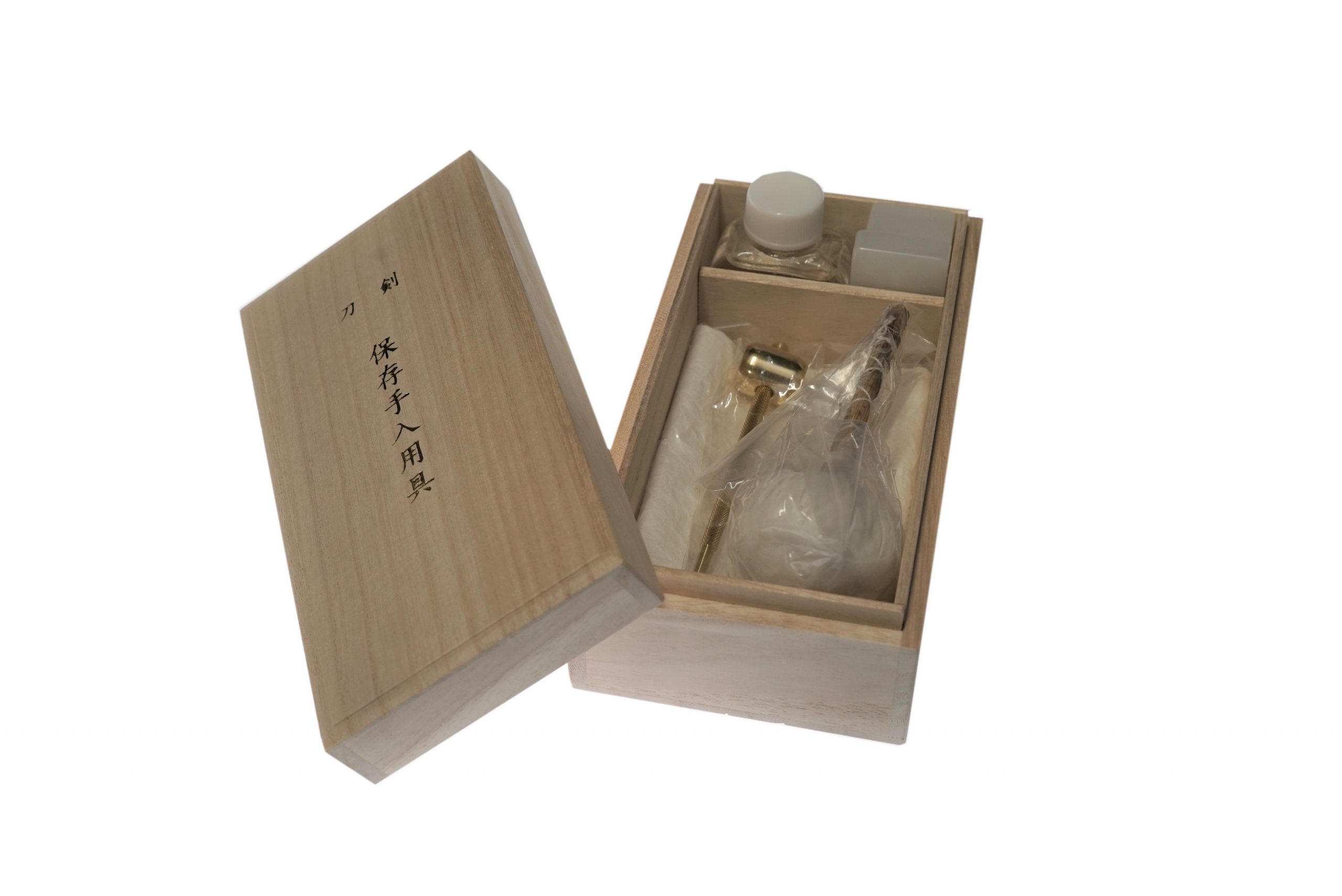
MORE ANTIQUE JAPANESE SWORD FOR SALE
SWORDS WITHOUT CERTIFICATES FOR SALE
LEARN JAPANESE SWORD TERMINOLOGY
Thank you for reading all the information on the page. If you have any difficulty choosing the right Japanese sword for you, we will be more than happy to help you find the one that speaks to you the most. Please feel free to contact us.


